Having a successful and imposing return of serve all boils down to one word – TIME.
Specifically, you want to find ways to buy time for yourself with your return all while still pressuring your opponents and giving them less time and space.
Why do you need to create time when returning?
That means that the returning team has the first opportunity to hit a volley, if they wish.
Well, one big advantage for the returning team is created by the two bounce rule. The ball must bounce twice after the serve before anyone can hit a volley. Once on the returning team side and once on the serving team’s side.
This affords them the luxury of advancing to the net after the return if they choose to. And, you absolutely should choose to every time you can because pickleball, like most sports, is a ground war.
The team that is up at the net generates the most opportunities for themselves to get high contact points with which they can hit down and away or hard and through. It’s the most offensive court positioning you can have and you want to achieve it early and often in every point.
As the returner why might you need time? What are you buying time for?
Since none of us humans travel at the speed of light, we all need some time to move from near the baseline from where we are likely hitting the return, to the net. We want to do so in such a way as to establish good positioning before the next shot is being struck by the opposing team.
Ideally, you’d like to get all the way up after the return or if that’s not possible you’d at least like to get as close as you can to that non-volley zone line before the opponents are striking the ball.
Hopefully you can at least make it more than halfway up from the baseline or more.
How do you buy time for yourself so you can get up to the net and impart maximum pressure on your opponents?
That’s exactly what we’re going to learn in today’s blog.
For the situational examples in this blog we’re going to be using a skinny singles format using the odd side only. We’re simulating doubles with two players and they can only play out the point cross-court. If they hit it down the line it’s out in this format.
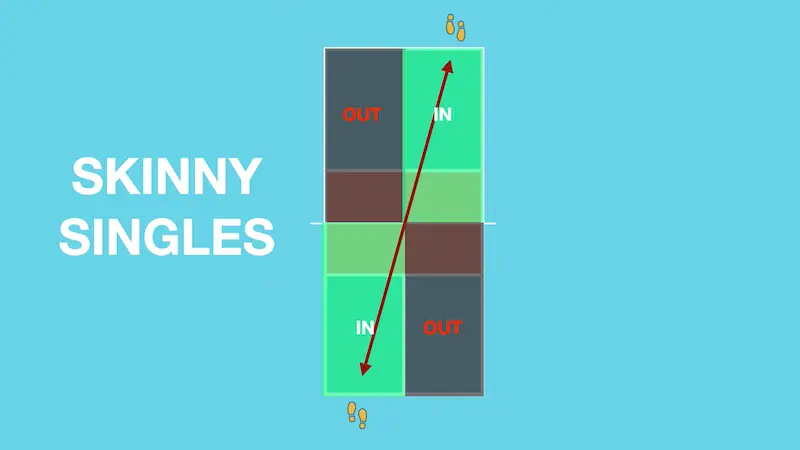
Skinny singles is a great way to practice your doubles game. Since you’re going to hit every shot that comes on your side, you’ll get a lot more touches on the ball and therefore a lot more repetitions in the same amount of time when compared to playing regular doubles with four players.
If you’re seeking to improve quickly then skinny singles is something that you’ll want to add to your pickleball routine.
With that in mind, a point that illustrates something that we see all too often out on the courts is a serve that is on the deeper side. It’s past the halfway mark of the service box, so not very deep, but it’s an okay serve.
In this scenario, the returner let the serve come in and he is still pinned pretty far back by the time he’s done with the return. He wants to get to the net so he begins making his way up there despite the return being short.
The server rips a third shot drive at the returner’s feet making for a tough fourth shot because he’s quite far back when he could have been further up. The ball floats high and the server attacks and the block is missed.
Now we’re going to cover all the things that the returner could have done better that could have led to him being well established. In the image below, you will see how he could have been further up at the yellow line on the forth shot instead of back where he is standing.
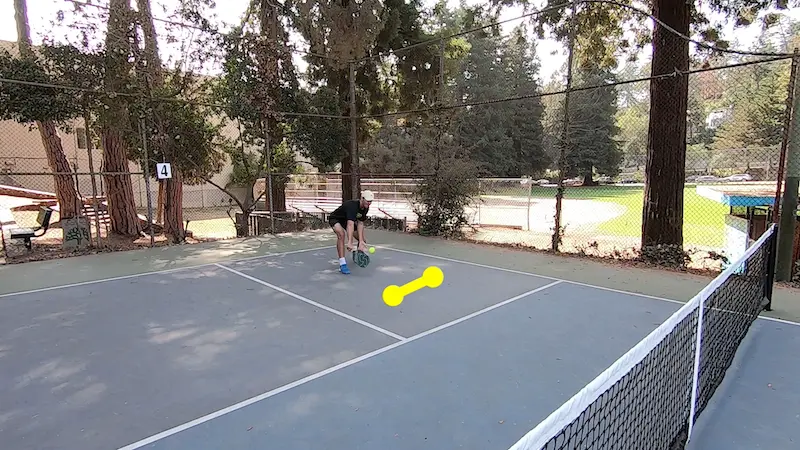
We’ll also cover some other scenarios that often happen with the same result and again tell you how you can turn things around and make the trip to the net a whole lot easier for yourself when you’re the returning player. And, as I mentioned previously, it comes down to finding ways to buy time.
Now that we know the parameters let’s get into it.
One of the key ways to buy time is to be sure to give yourself enough space to receive the serve.
So, unless the wind is blowing hard at your back or the current server is notorious for always hitting short serves, you’ll want to back it up to around the spot indicated in the image below and adjust accordingly based on the known tendencies of the server and how strong a serve they have.
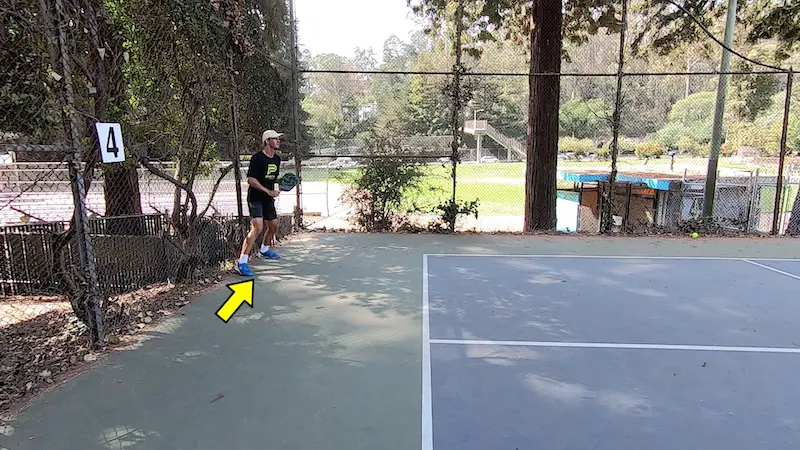
From here you afford yourself the time to let the serve bounce, peak, and still be able to hit it out in front, and moving through the return, as you hit it.
That is the key thing that all strong returners do.
They have momentum and are in forward motion as they strike the return so that they are covering distance towards the non-volley zone line as they are returning.
If you are static when you return then you are not covering any ground during that time and you now have more ground to cover while the ball is already on its way back over to your opponents. You’ve now lost some valuable time and are playing catch-up instead of getting ahead. That may prove to be costly.
Another key way to buy yourself time is to hit the return deep.
The longer you can keep your shot in flight, the more time you have to get up to the line.
Of course when we’re talking distance, a farther distance keeps your ball in flight longer than a shorter distance. So, you want to use the maximum distance available to you which will put your ideal target deep.
This has the added benefit of making third shots harder for the serving team.
Often they’ll be attempting a third shot drop which is much harder to achieve from the spot indicated on the right of the below image relative to the left side of the image.
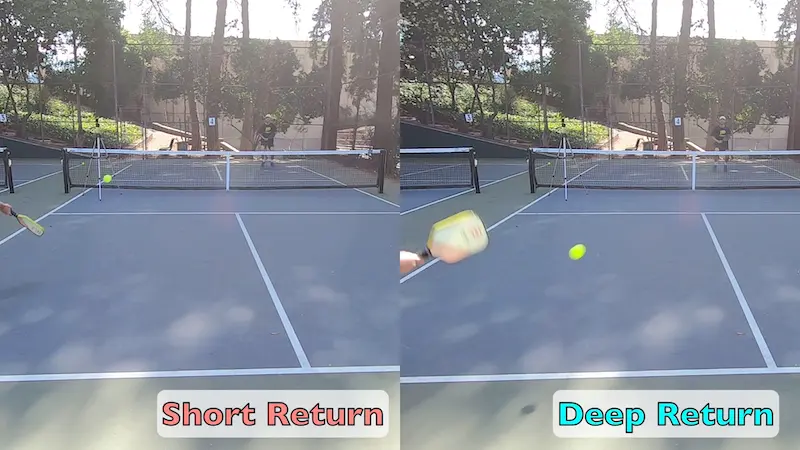
Your deep return that they must let bounce will force them to have to hit that third shot from farther back in the court all while you’re crashing the net and your partner is already up there.
Hitting a good shot, while facing your team’s imposing core positioning, plus the place from which they’re hitting, can often prove to be a difficult task for them and is to your advantage.
In addition to hitting it deep and buying yourself time with the long flight of the ball, another thing you can do is to hit it slower. It will take longer to get there as opposed to a fast and hard hit return. Thus again, buying you even more time to make your transition to the net.
One of the best ways to hit the ball slower is to use slice.
Slice also has the benefit of skinning off the ground which will keep it lower after the bounce. The spin can often complicate the timing of a clean contact for your opponent which is also to your benefit.
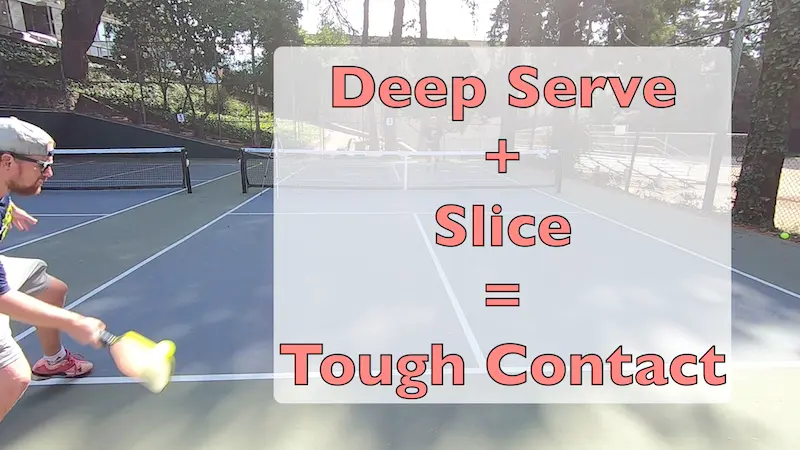
You can also simply hit a regular flat return, with a bit more height and loft to it, which you can hit slower and deep, if slice is not yet in your repertoire of shots. That should still be quite effective. There’s nothing wrong with that.
One of the most common things we see on the return is a strong desire to hit it with one’s forehand since typically players tend to have a stronger forehand than backhand.
The challenge with running around a shot when you could use the side to which the shot came to hit it, is that it can put you in a significantly compromised position and cost you a lot of time.
You’ll now be way out of position and have to cover a much longer distance to get to the non-volley zone line than if you had simply taken it with the side to which the shot came.
You can run around your shot somewhat to hit the other shot and it might be okay depending on how quick you are. Or, it might produce a problem and cost you a lot of time leading to lost points that didn’t need to be.
Each person must decide for themselves how far over they can go and take it with their other shot, often a forehand, all while still not giving away so much time that it will significantly impact your next shot, leading you to get behind in the point and ultimately losing it as a result.
Your best bet is to build up your weaker side, often the backhand, so that you trust it and can rely upon getting it deep and coming in behind it.
Having a reliable shot on both sides will open up so many opportunities for you in your entire game. It’s really to your benefit to not be overly reliant on one side.
If you look at all the best players they are solid on both wings. One side may be more potent than the other, and they like to attack with it more, but the less potent side is usually still very reliable.
You need to make time your friend on the return so you can get to the net fast and dominate the point early and often. That is a sure way to help you come out ahead in points and games.
Use these tips to ramp up your returning game.